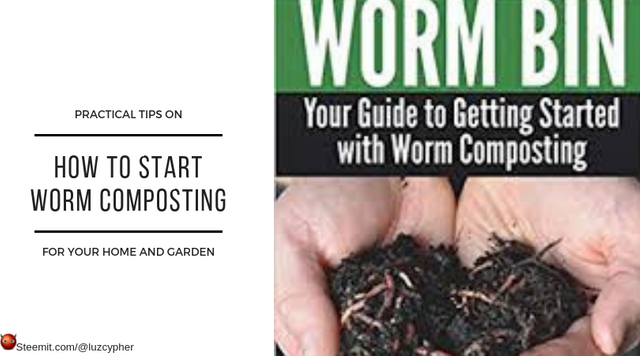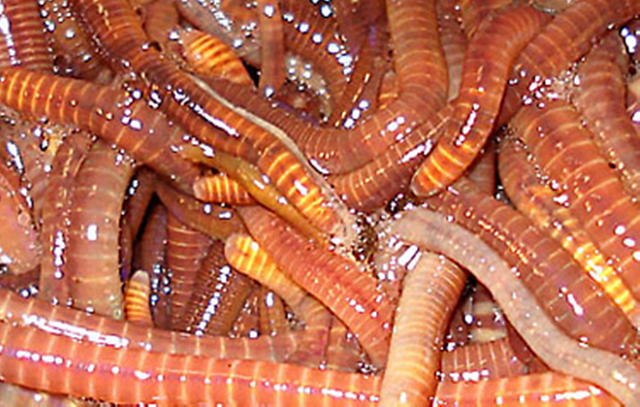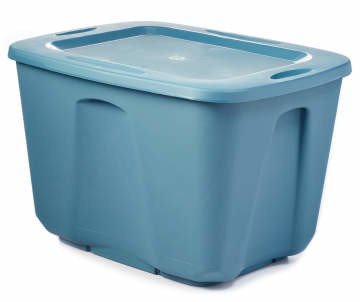How To Start Worm Composting Kitchen Scraps In Your Home
I got my first job when I was 10-years-old growing worms for Mr. Dove. We used to grow night crawlers for fishermen and it was a very profitable business. Since then my fascination with growing worms has only grown and creating compost is one of the best things you can do for the environment.
Worm composting is an easy way to turn food scraps and organic matter into the best compost for your garden and houseplants. Kids love it and can learn about recycling and it takes very little space to do even in your kitchen.
Often people think having worms in your kitchen is going to smell bad, but if done correctly that won't happen. In fact, the reason why food scraps smell bad in your garbage can is because there are no worms in your garbage can breaking down organic waste the way nature does.

Building a worm compost bin in your kitchen and adding all your food scraps to it will keep those scraps out of your garbage which means dogs and other animals will not be attracted to your cans, your garbage man will love you and so will the earth.
The worst thing people do is put organic waste in a plastic bag tie a knot in it and throw it away. This creates an anaerobic situation that turns the organic waste into a toxic sludge which is the leading environmental problem of landfills and water pollution.
EPA estimates that more food reaches landfills and incinerators than any other single material in our everyday trash, constituting 22 percent of discarded municipal solid waste. You might even pay less for trash pickup by keeping wasted food out of the garbage.
We can turn that problem into a solution by turning what would otherwise be toxic waste into a life-giving benefit and resource and all you have to do is drop your food waste into a different container than the rest of your garbage. The end result will be an abundance of worm castings for your garden and housplants.
Worm castings are the richest natural fertilizer known to humans. That's right: as little as a tablespoon of pure worm castings provides enough organic plant nutrients to feed a 6" potted plant for more than two months. Worm castings stimulate plant growth more than any other natural product on the market. Unlike animal manure and artificial fertilizers, it is absorbed easily and immediately by plants. But Worm Castings don't only stimulate plant growth: they also enhance the ability of your soil to retain water (because of its texture), and it even inhibits root diseases such as root rot. source
How To Start A Worm Composting Bin
To start worm composting you'll need a container filled with moist, shredded newspaper and leaves and some redworms (Eisenia fetida).
**A plain plastic container with tight-fitting lid makes a great worm compost bin for a small home or apartment. A bin sized 2'Wx4'Lx1'H is good for a 2-3 person household disposing of about 8 lbs/3.6kg of food scraps per week. The recommendation is that a container should provide one square foot of surface area for every pound of food waste per week. (Some experts suggest the height to be 8-12 inches, and the length as little as 3-feet.) The bin should have drainage holes on the bottom, a bottom catch tray, and air vents on top and sides. I like to use a bucket underneath the bin to catch liquids that drain out of a hole on the bottom of the bin.
Adding materials into the bin in layers like making lasagna with a layer of wood chips or course materials on the bottom about 2"/5cm this way it gets more air circulating and allows the liquid to drain out easily.
Then add a 2"/5cm layer of shredded, moistened newspaper followed by a 2"/5cm layer of shredded leaves. Continue alternating the layers until the bin is about half full. You want the layers to be moist but not soaking wet. The resulting consistency of the bedding material should be that of a well-wrung sponge.
Some best options to use as material include:
- Shredded newspaper (shredded in strips by hand) and corrugated cardboard (any ink is not a problem)
- Shredded fall leaves (or small whole ones)
- Dried grass clippings
- Seaweed
- Chopped-up straw and other dead plants
Fluffing the bedding is important to create air spaces for aerobic activity, odor control, and to give worms free movement inside the bin.
Worms need grit so they can digest their food so mix in some sand and soil into the mixture to provide it to them.
Adding Your Worms
Once everything is set up you can add you redworms. Worms like a moist, dark environment. Their bodies are 75 to 90 percent water so their body surfaces must be moist for them to breathe. Worms need to be kept out of the hot sun, heavy rain and cold. Worms enjoy temperatures between 40°F/4.4°C and 80°F/27°C, with temperatures in the 70s(F) perfect.
Make sure you use redworms aka red wrigglers, not the big nightcrawlers which need deeper soil to survive. Red wrigglers can be bought online or you might ask a gardener to give you some.
1 lb/0.45kg of worms is about 500 worms and will eat the same weight in food each day. To figure out how many worms you need just weigh how much food scraps your home produces for a week and divide it by seven to get your daily amount. Get the same weight in worms and you'll be good.
You can buy composting worms in the US at:
- https://worm-composting.ca/worm-composting/
- https://unclejimswormfarm.com/
- https://www.planetnatural.com/product/red-wiggler-worms/
- EBay
If you don't start with enough worms don't worry because worms will reproduce quickly in their new home. They can double their numbers in about 90-days so if you start out with fewer worms that's OK.
Once you get your worms just lay them on top of the material in your bin. Their skin is sensitive to light and they will tunnel down into the bin.

Feeding Your Worms
Feeding your new worms is easy. Just throw your food scraps into the bin. You can cut the scraps into smaller pieces but it's not really necessary. The worms will surface to grab the food and pull in down into their tunnels.
You can also divide your bin into imaginary sections and bury the food scraps into one section every few days so the worms don't have to travel to the surface and this will help the food break down quicker, but it's really not necessary unless you are producing more food scraps than usual.
Things worms love to eat include:
- fruit
- vegetables
- banana peels
- coffee grounds and tea leaves
- raw or cooked foods
- paper towels, napkins.
Some things you should try to avoid feeding your worms because it will smell more are:
- Dairy
- Cheese
- Meat
Some things will actually harm your worms and should be totally avoided:
- Garlic
- Onions
- Uncooked potato skins. Cooked is fine.
- Citrus peels like lemon, orange, or grapefruit.
TIP: Worm composting takes a little practice and planning at first. Remember that your bin should provide one square foot of surface area for every pound of food waste per week. For example, a bin 2 feet in width, 4 feet in length, and 1 foot in height would have 8 different sections. If each section gets a pound of food, as recommended, then you will need two pounds of red worms. A common mistake among beginners is having too few worms. One soon discovers that the food scraps in each section are not being eaten fully before additional scraps are put into that section 8-9 days later. Eventually, the worms will multiply and be plentiful for all sections. source
Making Worm Compost Tea
Worm tea is the liquid concentrate of worm compost. Minerals and microbial elements are extracted from the solid compost by actively brewing in water by means of an air pump which forces oxygen into the liquid.
Add some of the worm compost to a bucket with water to make lots of worm tea. Add the compost to a porous bag placed in a bucket of unchlorinated water and let it soak overnight. If your water is chlorinated just left the water sit in the bucket for 24-hours before adding the bag and the chlorine will evaporate. It's important to use unchlorinated water because chlorine will kill the microbes in the tea making it less effective.
Worm tea is ultimately the end result of steeping worm castings or vermicompost in water. Worm tea is known mostly for its ability to boost microbiological activity in soil by adding bacteria, fungi, actinomycetes, and protozoa to the soil. source
While a compost extraction can be made by simply stirring, it's made even better if continuous oxygen is incorporated into this "compost broth" which can increase the original numbers of microbes into the billions. This is known as AACT or actively aerated compost tea. In this case, worm tea.
Check out this website for more details on how to make the most beneficial, aerobic compost tea.
DIY Home Worm Composting Videos
This cool time-lapse video shows the layers of a worm compost bin and how the process works over time to create worm compost
Layered worm bin 8-week time-lapse - FAST PLAYBACK - vermicomposting
How to start a worm farm in 4 steps: vermiculture made easy
Vermicomposting is one of the best things you can do for the environment, your garden, and will reward you with the best fertilizer on the planet.
More Worm Composting Information
- Uncle Jim's Worm Farm is a wealth of information and a great resource for red worms in the US.
You can solve all the world's problems in a garden
Related Posts
How To Capture And Utilize Every Drop Of Water On Your Farm Using Keyline Water Design
Master Class On Making Compost
What Is Permaculture? - Permaculture Basics With Geoff Lawton
Chickens Planting Gardens - How To Get Chickens To Plant Gardens, Not Destroy Them
Quit My Six Figure Job To Grow A Food Forest
My Year Long, Unforgettable Woofing Adventure On Skipley Farm
Luzcypher's Announcement For Steem Witness





I have made my own compost bin by using 3 palettes and placing them on a wall. It seems like a big box and the voids in the palettes let air circulation around the compost. I feel that oxygen is useful for the process. Also I never used worms, but I find in there some well fed white grubs. It seems that in winter they work less, but when the weather is hot and rather moist they work better!
Posted using Partiko Android
That's a good way to make lots of compost. I've made mountains of compost, Good shit.
Just posted my gardening tips along with some pictures:
https://steemit.com/gardening/@laviq/a-gardening-story
Lovely, I’m glad to see you bringing enlightenment on Gardening and Agriculture in general. Just like you’re doing well in music 🎶; I’m glad that you’re also grooming people here on gardening.
Posted using Partiko iOS
Thanks. I love growing food and food forests as well as gardening. Do you garden?
Will start soonest. Thanks 🙏🏽
Posted using Partiko iOS
Cool, when you start worm composting you'll wonder why you waited so long. Please send a link back here when you post about it. and good luck.
Thanks sir for the encouragement, your kind words, and best wishes.